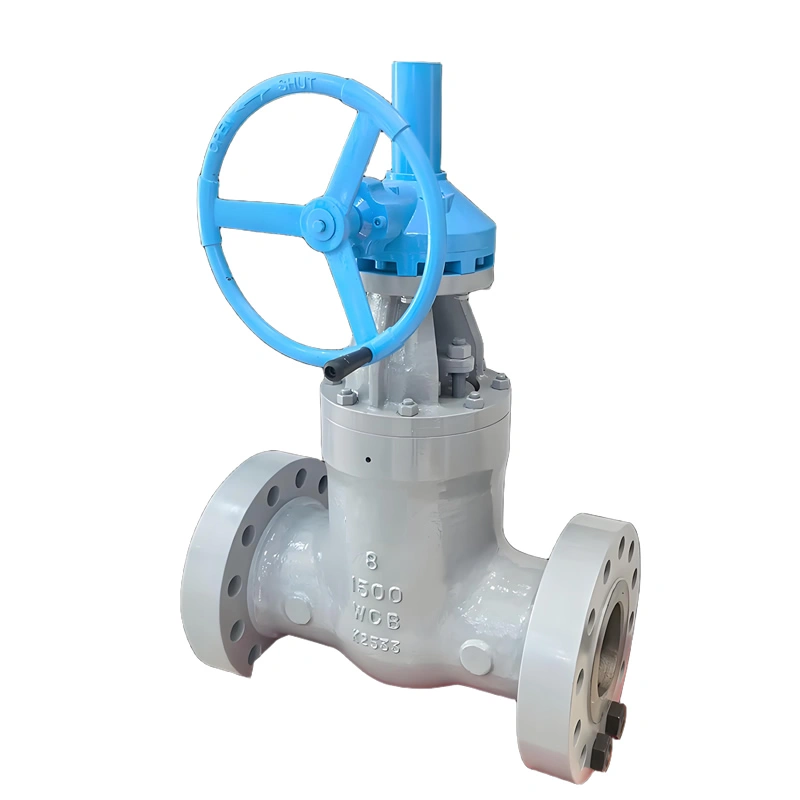- DN50-DN800
- API60D or API600,JIS B2073-2083
- ANSI B16.10 and JISB2002
- ANSI B16.25
- 150Lb, 300LB, 600LB 900Lb, 1500LB, 2500LB
- Carbon steel (WCB), stainless steel (304\304L\316\316L)
- carbon steel ≤425 ℃, stainless steel ≤200℃
Specification
Hard sealed Manual Cast Steel WCB High Pressure Control Gate Valve
I. Product Overview: Reliable Interception Solution for High-Temperature and High-Pressure Conditions
NEWWAY’s hard-sealed manual cast steel gate valve, constructed from WCB cast steel, is specially designed for high-temperature and high-pressure conditions. It achieves reliable medium interception through the precise hard-sealed structure between the gate and seat. Complying with international standards such as API 60D and API 600, the product is suitable for industrial fluid control of water, steam, oil, acid-base media, etc., widely applied in key sectors like power stations, petrochemicals, and metallurgy. Its core advantage lies in the wear-resistant and corrosion-resistant properties of the hard-sealed surface, combined with a manual operating mechanism to provide stable on-off control for high-pressure systems.
II. Key Attribute Parameters: Comprehensive Technical Index Analysis
|
Parameter Category |
Specific Indicators |
|
Nominal Diameter Range |
DN50~DN1500 (NPS2″~NPS60″), covering small-to-medium to extra-large diameter systems |
|
Pressure Class |
Class 150~Class 2500 (PN16~PN420), suitable for low to ultra-high pressure conditions |
|
Execution Standards |
Design standards: API 60D, API 600, JIS B2073; |
|
Connection Types |
Flanged (RF raised face, RTJ ring joint), Butt Weld (BW), Socket Weld (SW), compliant with ANSI B16.25 |
|
Material System |
– Body: WCB cast steel (≤425℃), 304/304L/316/316L stainless steel (≤200℃); |
|
Operation Modes |
Manual, electric, bevel gear operation, supporting on-site manual emergency operation and automation control integration |
|
Applicable Media |
Corrosive or high-temperature fluids such as water, steam, oil-gas, acid-base media |
Product Overview
III. Core Features: Hard-Seal Technology and Operational Adaptability
Advantages of Hard-Seal Structure
The seat and gate are hardfaced with carbide alloys (e.g., Stellite), with surface hardness ≥HRC58. The wear resistance is over 3 times that of ordinary steel, capable of withstanding high-velocity fluid erosion and particle medium wear—especially suitable for interception scenarios involving solid particles or high-viscosity media. The sealing surface uses a grinding process with flatness error ≤0.01mm, achieving zero-leakage sealing (bubble-tight standard).
Wide Temperature and Pressure Adaptability
Temperature Resistance: WCB material ensures stable operation within -29℃~425℃, while stainless steel adapts to low-temperature environments with corrosive media;
Pressure Resistance: Class 2500 products can withstand 42MPa high pressure. The valve body adopts a thickened design, with pressure-bearing capacity 20% higher than conventional valves, meeting strict conditions like high-pressure steam pipelines and wellhead devices.
Multi-Standard Compatibility and Installation Flexibility
Products comply with international standards such as API, JIS, and ANSI, with flange dimensions and face-to-face lengths compatible with mainstream international projects. Connection types cover flanged and welded options, supporting sealing forms like RF raised face and RTJ ring joint to adapt to installation needs of different pipeline systems.
IV. Manufacturing Processes: Precision Control from Material to Finished Product
Raw Material Selection and Pretreatment
WCB cast steel uses an electric furnace melting + out-of-furnace refining process, with sulfur and phosphorus content controlled below 0.03% to ensure material impact resistance. Stainless steel materials undergo vacuum degassing to reduce inclusions and enhance corrosion resistance. All materials must pass spectral analysis, tensile testing, and impact testing to ensure composition and mechanical properties meet standards.
Precision Casting and Machining
Casting Process: Resin sand precision casting is adopted, with the valve body surface finish Ra≤12.5μm and dimensional tolerance controlled within ±0.5mm to avoid casting defects;
Machining: CNC vertical lathes and machining centers are used for precision machining of sealing surfaces, combined with special grinding equipment to achieve sealing surface roughness Ra≤0.8μm, ensuring the fitting accuracy of the sealing pair.
Full-Process Quality Control
Pressure Testing: Each valve must pass a shell strength test at 1.5x design pressure and a sealing test at 1.1x design pressure, with pressure maintained for ≥15 minutes without visible leakage;
Nondestructive Testing: Key welds undergo RT radiography (Grade II qualification), and casting surfaces use MT magnetic particle testing to eliminate defects such as cracks and pores;
Life Testing: Sampling for 5,000 on-off cycle tests to ensure no degradation in sealing performance, guaranteeing long-term reliability.




